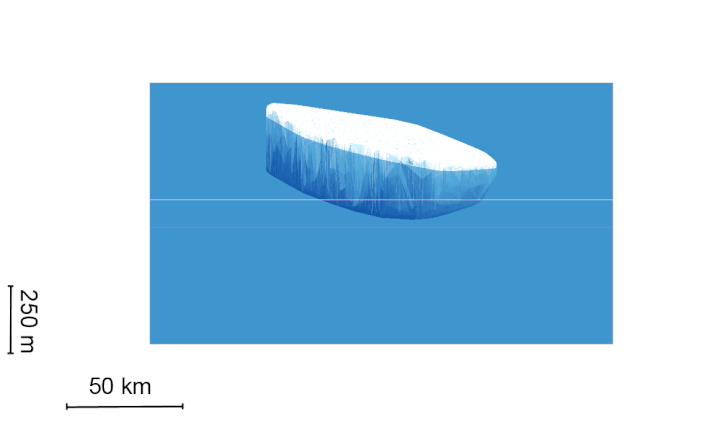Antarctica's Larsen C Iceberg Will Tower 600 Feet Over the Ocean
It hasn't calved yet, but scientists already have a pretty good idea of what the iceberg splitting from Antarctica's Larsen C ice shelf will look like.
Using satellite measurements from the European Space Agency (ESA), researchers have found that the new 'berg will tower 623 feet (190 meters) high over the ocean's surface and contain 277 cubic miles (1,155 cubic kilometers) of ice. The surface area of the ice threatening to break off is around 2,548 square miles (6,600 square km), slightly larger than the state of Delaware.
Scientists observing the ice shelf say the iceberg could calve off within days or weeks, though the exact timeline is impossible to predict. [In Photos: Antarctica's Larsen C Ice Shelf Through Time]
A growing rift
The Larsen C ice shelf sits along the Antarctic Peninsula and is the fourth-largest ice shelf in Antarctica. Researchers first noticed a rift in the ice sheet on satellite imagery in 2014, according to the U.K.-based MIDAS Project, an Antarctic research group. By November 2016, the rift had grown to more than 300 feet (91 m) in width and 70 miles (112 km) in length. By January, it was 109 miles (175 km) long. According to the European Space Agency's most recent observations, the rift is now around 124 miles (200 km) long. Only 3 miles (5 km) of ice connect the soon-to-be iceberg with the rest of the ice shelf.
Project MIDAS researchers measuring the speed of the ice's movement in late June found that the far end of the iceberg moved at a speed of 33 feet (10 m) a day between June 24 and June 27, which is the fastest rate of ice movement ever recorded on the Larsen C ice shelf. When the rift finally splinters the ice sheet, the iceberg will carry away between 9 percent and 12 percent of the ice sheet's surface area.
This disruption could speed the dissolution of the entire ice sheet, Project MIDAS scientists say. The Larsen ice sheet has lost 75 percent of its mass since 1995, according to the National Snow and Ice Data Center. In 1995, a 580-square-mile (1,500 square km) piece of the Larsen A section of the ice sheet crumbled away; in 2002, the Larsen B section lost 1,255 square miles (3,250 square km). The Larsen C iceberg will represent a larger loss than either of those events.
Predicting the collapse
Now, scientists with the ESA's CryoSat mission have used data from the Earth Explorer satellite to better quantify the size of the Larsen C iceberg. The satellite uses an instrument called a radar altimeter to measure the elevation of the ice. It works by shooting a beam of radio waves down toward Earth and then measuring how long it takes those waves to bounce back, thus making detailed maps of the topography.
Get the world’s most fascinating discoveries delivered straight to your inbox.
The researchers estimate that in addition to the above-surface elevation of the iceberg, the ice could plunge as deep as 689 feet (210 m) below the sea surface.
Monitoring an iceberg of that size is important, according to the ESA, because it could run afoul of shipping traffic. However, researchers aren't sure whether the iceberg will remain in one piece for long.
"It could, in fact, even calve in pieces or break up shortly after [calving]," mission researcher Anna Hogg of the University of Leeds said in a statement. "Whole or in pieces, ocean currents could drag it north, even as far as the Falkland Islands."
Original article on Live Science.

Stephanie Pappas is a contributing writer for Live Science, covering topics ranging from geoscience to archaeology to the human brain and behavior. She was previously a senior writer for Live Science but is now a freelancer based in Denver, Colorado, and regularly contributes to Scientific American and The Monitor, the monthly magazine of the American Psychological Association. Stephanie received a bachelor's degree in psychology from the University of South Carolina and a graduate certificate in science communication from the University of California, Santa Cruz.



